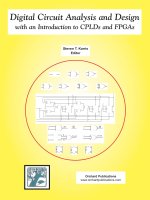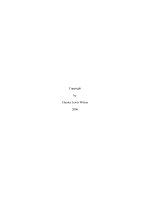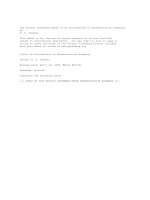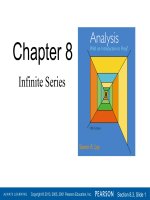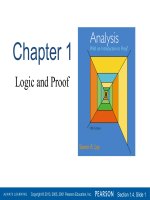Analysis with an introduction to proof 5th by steven lay ch05
Bạn đang xem bản rút gọn của tài liệu. Xem và tải ngay bản đầy đủ của tài liệu tại đây (303.65 KB, 17 trang )
Chapter 5
Limits and Continuity
Copyright © 2013, 2005, 2001 Pearson Education, Inc.
Section 5.2, Slide 1
Section 5.2
Continuous Functions
Copyright © 2013, 2005, 2001 Pearson Education, Inc.
Section 5.2, Slide 2
Definition 5.2.1
Let f : D →
and let c ∈ D. We say that f is continuous at c if
for each ε > 0 there exists a δ > 0 such that | f (x) – f (c)| < ε
whenever | x – c | < δ and x ∈ D .
If f is continuous at each point of a subset S of D, then f is said to be continuous on S.
Notice that the definition of continuity at a point c requires c to be in D, but it
does not require c to be an accumulation point of D.
In fact, if c is an isolated point of D, then f is automatically continuous at c.
For if c is an isolated point of D, then there exists a δ > 0 such that, if | x – c | < δ
and x ∈ D, then x = c.Thus whenever | x – c | < δ and x ∈ D, we have
| f (x) – f (c) | = 0 < ε for all ε > 0. Hence f is continuous at c.
Copyright © 2013, 2005, 2001 Pearson Education, Inc.
Section 5.2, Slide 3
Theorem 5.2.2
Let f : D →
and let c ∈ D. The following three conditions are equivalent:
(a) f is continuous at c.
(b) If (xn) is any sequence in D such that (xn) converges to c, then
lim n → ∞ f (xn) = f (c).
(c) For every neighborhood V of f (c) there exists a neighborhood U of c
such that f (U ∩ D) ⊆ V.
And, if c is an accumulation point of D, then the above are all equivalent to
(d) f has a limit at c and lim x → c f (x) = f (c).
Proof:
Suppose first that c is an isolated point of D.
Then there exists a neighborhood U of c such that U ∩ D = {c}.It follows that,
for any neighborhood V of f (c), f (U ∩ D) = { f (c)} ⊆ V. Thus (c) always holds.
Similarly, by Exercise 4.1.16, if (x ) is a sequence in D converging to c, then
n
x ∈ U for all n greater than some M. But this implies that xn = c for n > M,
n
so lim
f (x ) = f (c). Thus (b) also holds.
n → ∞
n
We have already observed that (a) applies, so (a), (b), and (c) are all equivalent.
Copyright © 2013, 2005, 2001 Pearson Education, Inc.
Section 5.2, Slide 4
Theorem 5.2.2
Let f : D →
and let c ∈ D. The following three conditions are equivalent:
(a) f is continuous at c.
(b) If (xn) is any sequence in D such that (xn) converges to c, then
lim n → ∞ f (xn) = f (c).
(c) For every neighborhood V of f (c) there exists a neighborhood U of c
such that f (U ∩ D) ⊆ V.
And, if c is an accumulation point of D, then the above are all equivalent to
(d) f has a limit at c and lim x → c f (x) = f (c).
Proof:
Now suppose that c is an accumulation point of D.
Then (a) ⇔ (d) is Definition 5.1.1,
(d) ⇔ (c) is Theorem 5.1.2,
and (d) ⇔ (b) is essentially Theorem 5.1.8. ♦
Let’s look at this graphically.
Copyright © 2013, 2005, 2001 Pearson Education, Inc.
Section 5.2, Slide 5
f is continuous at c iff
for each ε > 0
there exists a δ > 0
such that | f (x) – f (c)| < ε whenever | x – c | < δ and x ∈ D.
Or, in terms of neighborhoods, for each neighborhood V of f (c),
such that f (U ∩ D) ⊆ V.
there exists a neighborhood U of c,
f
f (c) + ε
f (c)
V
f (c) – ε
c–
δ
Copyright © 2013, 2005, 2001 Pearson Education, Inc.
c
U
c+
δ
Section 5.2, Slide 6
Example 5.2.3
Let p be a polynomial. We saw in Example 5.1.14 that for any c ∈
It follows that p is continuous on
, lim x → c p(x) = p(c).
.
Example 5.2.5
Let f (x) = x sin (1/x) for x ≠ 0 and f (0) = 0. Here is the graph:
It appears that f may be
continuous at x = 0.
Let’s prove that it is.
Copyright © 2013, 2005, 2001 Pearson Education, Inc.
Section 5.2, Slide 7
We claim that the function defined by f (x) = x sin (1/x) for x ≠ 0 and f (0) = 0
is continuous at x = 0.
f ( Since
x) − f (0) = x sin
1
≤for|allx x,|
x
given ε > 0, we may let δ = ε .
Then when | x – 0 | < δ we have | f (x) – f (0)| ≤ | x | < δ = ε .
The negation of (a) and (b) in Theorem 5.2.2 gives a useful test of discontinuity.
Theorem 5.2.6
Let f : D →
and let c ∈ D. Then f is discontinuous at c iff there exists a
sequence (xn) in D such that (xn) converges to c but the sequence ( f (xn)) does
not converge to f (c).
Copyright © 2013, 2005, 2001 Pearson Education, Inc.
Section 5.2, Slide 8
Example 5.2.8 describes a function (the Dirichlet function) that is discontinuous
at every real number.
Define f :
→
by
f (x) =
1,
if x is rational,
0,
if x is irrational.
If c ∈
, then every neighborhood of c will
contain rational points at which f (x) = 1 and
also irrational points at which f (x) = 0.
Thus lim x → c f (x) cannot possibly exist and f is discontinuous at each c ∈
Copyright © 2013, 2005, 2001 Pearson Education, Inc.
.
Section 5.2, Slide 9
Example 5.2.9 describes a modified Dirichlet function.
Define f : (0, 1) →
1
n ,
0,
by f (x) =
1
if x =
m
is rational in lowest terms
n
if x is irrational.
f (1/2) = 1/2
•
2
1
•
f (1/3) = f (2/3) = 1/3
•
3
•
•
••
•
•
•
•
•
•
•
•
•
•
•
•
•
f (1/4) = f (3/4) = 1/4
•
•
•
•
•
•
•
•
•
•
•
•
•
1
1
2
3
2
3
•
•
•
•
•
f
••
•
(
)
1/ 2 = 0
1
We claim that f is continuous at each irrational number in (0, 1) and
discontinuous at each rational in (0, 1).
Copyright © 2013, 2005, 2001 Pearson Education, Inc.
Section 5.2, Slide 10
Example 5.2.9 describes a modified Dirichlet function.
Define f : (0, 1) →
1
n ,
0,
by f (x) =
1
if x =
if x is irrational.
•
Let c be a rational number in (0, 1).
2
1
•
Let (xn) be a sequence of irrationals in
•
3
•
•
•
•
•
•
•
•
•
•
(0, 1) with xn → c.
•
•
•
•
•
•
1
3
•
•
•
c
•
•
•
m
is rational in lowest terms
n
•
•
•
•
•
•
•
•
1
2
2
3
•
•
•
•
•
Then f (xn) = 0 for all n, so
•
•
•
lim f (xn) = 0.
1
But f (c) > 0 since c is rational.
So lim f (xn) ≠ f (c) and f is discontinuous at c.
Copyright © 2013, 2005, 2001 Pearson Education, Inc.
Section 5.2, Slide 11
Example 5.2.9 describes a modified Dirichlet function.
Define f : (0, 1) →
1
n ,
0,
by f (x) =
1
if x =
m
is rational in lowest terms
n
if x is irrational.
•
Let d be an irrational number in (0, 1).
2
1
•
Given any ε > 0, there exists k ∈
•
such that 1/k < ε .
3
•
1/k
•
••
•
•
•
•
•
•
•
•
•
•
•
•
•
•
•
•
•
•
•
•
•
•
•
•
•
•
•
•
•
•
•
There are only a finite number of
••
•
rationals in (0, 1) with denominators
less than k.
1
d
3
1
2
2
3
1
Thus there exists a δ > 0 such that all the rationals in (d – δ, d + δ ) have a
denominator (in lowest terms) greater than or equal to k.
It follows that if x ∈ (0, 1) and | x – d | < δ , then | f (x) – f (d)| = | f (x)| ≤ 1/k < ε .
Hence f is continuous at d.
Copyright © 2013, 2005, 2001 Pearson Education, Inc.
Section 5.2, Slide 12
Theorem 5.2.10
Let f and g be functions form D to
and let c ∈ D. Suppose that f and g
are continuous at c. Then
(a) f + g and f g are continuous at c, and
(b) f /g is continuous at c if g(c) ≠ 0.
Proof:
Let (x ) be a sequence in D converging to c.
n
To show that f + g is continuous at c
it suffices by Theorem 5.2.2 to show that lim ( f + g)(x ) = ( f + g)(c).
n
From Definition 5.1.12 and Theorem 4.2.1, we have
lim ( f + g)(x ) = lim [ f (xn) + g (xn)]
n
= lim f (xn) + lim g (xn)
= f (c) + g(c) = ( f + g)(c).
The proofs for the product and quotient are similar, the only difference being that
for f /g we have to choose the sequence (x ) so that g (x ) ≠ 0 for all n. Recall that the
n
n
quotient is defined only at those points x ∈ D for which g (x) ≠ 0. ♦
Copyright © 2013, 2005, 2001 Pearson Education, Inc.
Section 5.2, Slide 13
Theorem 5.2.12
Let f : D →
and g: E →
be functions such that f (D) ⊆ E. If f is
continuous at a point c ∈ D and g is continuous at f (c), then the composition
g°f:D→
is continuous at c.
Proof:
Let W be any neighborhood of
D
E
( g ° f )(c) = g( f (c)).
W
U
Since g is continuous at f (c), there exists
V
a neighborhood V of f (c) such that
g( f (c))
c
f
f (c)
g
g(V ∩ E)
⊆
W.
Since f is continuous at c, there exists
a neighborhood U of c such that
f (U ∩ D)
Since f (D)
⊆
E, we have f (U ∩ D)
If follows that g( f (U ∩ D))
⊆
⊆
⊆
V.
(V ∩ E).
W,
so g ° f is continuous at c by Theorem 5.2.2.
Copyright © 2013, 2005, 2001 Pearson Education, Inc.
Section 5.2, Slide 14
Theorem 5.2.14
A function f : D →
an open set H in
is continuous on D iff for every open set G in
such that H ∩ D = f
–1
there exists
(G).
Corollary 5.2.15
A function f :
→
is continuous iff f
–1
(G) is open in
whenever G is open in
.
f
f
–1
(G )
U
G
V
c
f (c)
Proof:
Suppose f is continuous. Let G be an open set in
Suppose c ∈ f
–1
.
We want to show f
–1
(G) is open.
Then f (c) ∈ G.
(G).
Since G is open, there exists a neighborhood V of f (c) such that V
⊆ G.
Since f is continuous, there exists a neighborhood U of c such that f (U)
But then U ⊆ f
–1
(G) so c is an interior point of f
Copyright © 2013, 2005, 2001 Pearson Education, Inc.
–1
(G) and f
–1
⊆
V
⊆ G.
(G) is open.
Section 5.2, Slide 15
Theorem 5.2.14
A function f : D →
an open set H in
is continuous on D iff for every open set G in
such that H ∩ D = f
–1
there exists
(G).
Corollary 5.2.15
A function f :
→
is continuous iff f
–1
(G) is open in
whenever G is open in
.
f
f
–1
(V )
U
V
c
f (c)
Conversely, suppose G being open implies f
Given c ∈
So, f
–1
(V) is open.
f (U)
–1
(G) is open.
, let V be a neighborhood of f (c).
Since f (c) ∈ V, c ∈ f
Then V is open.
–1
(V).
Thus there exists a neighborhood U of c such that U ⊆ f
–1
(V).
But then f (U ) ⊆ V , and f is continuous at c. ♦
Copyright © 2013, 2005, 2001 Pearson Education, Inc.
Section 5.2, Slide 16
The following example shows how a discontinuous function might fail to have
the pre-image of an open set be open.
Example 5.2.16
Define f :
→
if x ≤ 2,
4,
if x > 2.
by f (x) =
Let G be the open interval (1, 3).
4
(
3
x,
)
Then f
G
–1
(G) = (1, 2], which is not open.
2
1
(
]
1
2
f
–1
3
4
(G)
Copyright © 2013, 2005, 2001 Pearson Education, Inc.
Section 5.2, Slide 17
